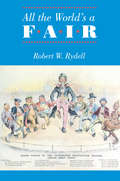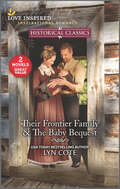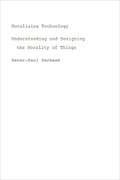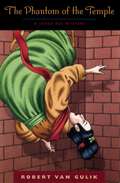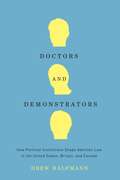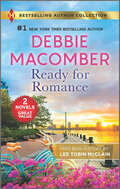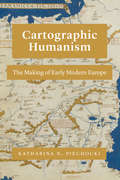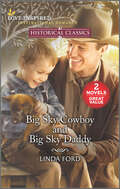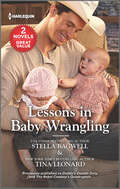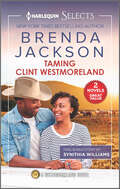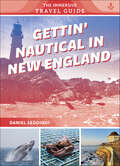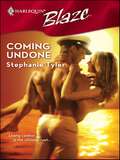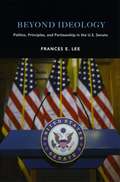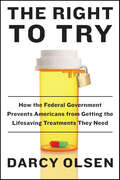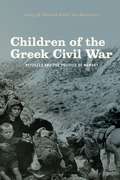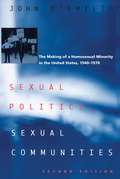- Table View
- List View
All the World's a Fair: Visions of Empire at American International Expositions, 1876-1916
by Robert W. RydellRobert W. Rydell contends that America's early world's fairs actually served to legitimate racial exploitation at home and the creation of an empire abroad. He looks in particular to the "ethnological" displays of nonwhites—set up by showmen but endorsed by prominent anthropologists—which lent scientific credibility to popular racial attitudes and helped build public support for domestic and foreign policies. Rydell's lively and thought-provoking study draws on archival records, newspaper and magazine articles, guidebooks, popular novels, and oral histories.
Their Frontier Family & The Baby Bequest
by Lyn CoteSecond-chance familyTheir Frontier FamilyNo one is more surprised than Sunny Licht when Noah Whitmore proposes. She’s an unwed mother—an outcast in her small Quaker community. But she can’t resist the Union soldier’s offer of a fresh start. Noah is determined that Sunny and her baby want for nothing…except the love that war burned out of him. Yet Sunny makes him hope once more for the family he never thought he’d find.The Baby Bequest Getting married is the only way for Sophie Tanner to protect her younger brother and keep her family’s Smoky Mountain farm. She’d like Nathan O’Malley to be the groom, but he can’t seem to get past their friendship…or their differences. Nathan always thought he’d fall in love with someone like himself—sensible and levelheaded. Sophie is his polar opposite. So why can’t he picture anyone else at his side? The moment schoolteacher Ellen Thurston discovers a baby boy outside her door, it’s love at first sight. While the townsfolk don’t approve of Ellen as a single mother, what worries her most are her feelings for Kurt Lang, the handsome farmer who defends her. Kurt knows how hard it is to raise a child alone, and he’ll do whatever it takes to help make Ellen’s dream of a family come true.USA TODAY Bestselling Author
Moralizing Technology: Understanding and Designing the Morality of Things
by Peter-Paul VerbeekTechnology permeates nearly every aspect of our daily lives. Cars enable us to travel long distances, mobile phones help us to communicate, and medical devices make it possible to detect and cure diseases. But these aids to existence are not simply neutral instruments: they give shape to what we do and how we experience the world. And because technology plays such an active role in shaping our daily actions and decisions, it is crucial, Peter-Paul Verbeek argues, that we consider the moral dimension of technology. Moralizing Technology offers exactly that: an in-depth study of the ethical dilemmas and moral issues surrounding the interaction of humans and technology. Drawing from Heidegger and Foucault, as well as from philosophers of technology such as Don Ihde and Bruno Latour, Peter-Paul Verbeek locates morality not just in the human users of technology but in the interaction between us and our machines. Verbeek cites concrete examples, including some from his own life, and compellingly argues for the morality of things. Rich and multifaceted, and sure to be controversial, Moralizing Technology will force us all to consider the virtue of new inventions and to rethink the rightness of the products we use every day.
The Cattleman Meets His Match and Second Chance Hero
by Winnie Griggs Sherri ShackelfordCan they take a leap of faith?The Cattleman Meets His Match by Sherri ShackelfordCowboy John Elder needs a replacement crew of cattle hands to drive his longhorns to Kansas—he just never figured they'd be wearing petticoats. Traveling with Moira O'Mara and the orphan girls in her care is a mutually beneficial arrangement. Yet despite Moira's declaration of independence, the feisty beauty evokes John's every masculine instinct to protect, defend…marry? Second Chance Hero by Winnie GriggsTo help his dying sister, Nate Cooper once broke the law—and he's regretted it ever since. So when the ex-con turned saddler saves Verity Leggett&’s daughter from imminent harm, he's shocked to be called a hero. But when his secrets come to light, will Verity be able to get over his past and see Nate for the caring man he's become?
Phylogenetic Ecology: A History, Critique, & Remodeling (Use R! Ser.)
by Nathan G. SwensonOver the past decade, ecologists have increasingly embraced phylogenetics, the study of evolutionary relationships among species. As a result, they have come to discover the field’s power to illuminate present ecological patterns and processes. Ecologists are now investigating whether phylogenetic diversity is a better measure of ecosystem health than more traditional metrics like species diversity, whether it can predict the future structure and function of communities and ecosystems, and whether conservationists might prioritize it when formulating conservation plans. In Phylogenetic Ecology, Nathan G. Swenson synthesizes this nascent field’s major conceptual, methodological, and empirical developments to provide students and practicing ecologists with a foundational overview. Along the way, he highlights those realms of phylogenetic ecology that will likely increase in relevance—such as the burgeoning subfield of phylogenomics—and shows how ecologists might lean on these new perspectives to inform their research programs.
The Phantom of the Temple: A Judge Dee Mystery (The Judge Dee Mysteries)
by Robert van GulikBased a historical figure, Judge Dee must solve the puzzle of a missing person, a robbery and a murder in this mystery set in Tang Dynasty China.Judge Dee presided over his imperial Chinese court with a unique brand of Confucian justice. A near mythic figure in China, he distinguished himself as a tribunal magistrate, inquisitor, and public avenger. Long after his death, accounts of his exploits were celebrated in Chinese folklore, and later immortalized by Robert van Gulik in his electrifying mysteries.In The Phantom of the Temple, three separate puzzles—the disappearance of a wealthy merchant’s daughter, twenty missing bars of gold, and a decapitated corpse—are pieced together by the clever judge to solve three murders and one complex, gruesome plot.“Judge Dee belongs in that select group of fictional detectives headed by the renowned Sherlock Holmes. I assure you it is a compliment not given frivolously.” —Robert Kirsch, Los Angeles Times
Doctors and Demonstrators: How Political Institutions Shape Abortion Law in the United States, Britain, and Canada
by Drew HalfmannSince Roe v. Wade, abortion has continued to be a divisive political issue in the United States. In contrast, it has remained primarily a medical issue in Britain and Canada despite the countries’ shared heritage. Doctors and Demonstrators looks beyond simplistic cultural or religious explanations to find out why abortion politics and policies differ so dramatically in these otherwise similar countries. Drew Halfmann argues that political institutions are the key. In the United States, federalism, judicial review, and a private health care system contributed to the public definition of abortion as an individual right rather than a medical necessity. Meanwhile, Halfmann explains, the porous structure of American political parties gave pro-choice and pro-life groups the opportunity to move the issue onto the political agenda. A groundbreaking study of the complex legal and political factors behind the evolution of abortion policy, Doctors and Demonstrators will be vital for anyone trying to understand this contentious issue.
Ready for Romance: Ready For Romance Ready For Marriage
by Debbie MacomberTwo wholesome reader-favorite romances from two New York Times–bestselling authors, collected in one book.Ready for Romance by #1 New York Times–bestselling author Debbie Macomber“Debbie Macomber is . . . a bona fide superstar.” —Publishers WeeklyAs a teenager, Jessica Kellerman was in love with one of the boys next door, Evan Dryden. Now an adult, Jessica is working for the Dryden brothers at their law firm. Evan finds her past crush amusing, but there’s a bigger problem—Jessica has actually fallen for Evan’s brother, Damian.No one will let Jessica forget her girlish infatuation, least of all Damian, who’s trying to be the ultimate matchmaker and set Jessica and Evan up once and for all. But how can she convince Damian of her true feelings when he’s still trying to push her toward his brother?FREE BONUS STORY INCLUDED IN THIS VOLUME!Child on His Doorstep by New York Times–bestselling author Lee Tobin McClainAfter his little brother is abandoned on his doorstep, Corbin Beck admits he needs help. Thankfully, former hometown party girl Samantha Alcorn is making a fresh start as a live-in nanny. With sparks flying, the unconventional situation has them feeling like family, but Samantha’s secret could change everything . . . “Child on His Doorstep certainly gave me food for thought and livened up my day, with this warm summery feel-good tale of maturing and redemption while caring for an unexpected responsibility.” —Fresh Fiction
Why the Best Man for the Job Is a Woman: The Unique Female Qualities of Leadership
by Esther Wachs BookPlaying With The Big Boys -- And Beating Them At Their Own Game!From Meg Whitman of eBay to Marcy Carsey of Carsey-Warner and Oxygen Media, today's leading businesswomen show how to make it in the notorious boys' club of corporate America.Gone are the days when men called the shots. More and more women have replaced men or excelled over rivals in male-dominated industries because they possess the qualities of leadership that top firms are seeking today. Esther Wachs Book introduces the new Female Leader and reveals the seven key, and uniquely female, qualities of leadership that are turning the world around -- and allowing more women to achieve success.Filled with compelling insights gleaned from the country's highest-ranking businesswomen, Why the Best Man for the Job Is a Woman reveals how these exceptional women have soared to the top and captures their strategies for success.
The Economics of Poverty Traps (National Bureau of Economic Research Conference Report)
by Christopher B. Barrett, Michael R. Carter, and Jean- Paul ChavasWhat circumstances or behaviors turn poverty into a cycle that perpetuates across generations? The answer to this question carries especially important implications for the design and evaluation of policies and projects intended to reduce poverty. Yet a major challenge analysts and policymakers face in understanding poverty traps is the sheer number of mechanisms—not just financial, but also environmental, physical, and psychological—that may contribute to the persistence of poverty all over the world. The research in this volume explores the hypothesis that poverty is self-reinforcing because the equilibrium behaviors of the poor perpetuate low standards of living. Contributions explore the dynamic, complex processes by which households accumulate assets and increase their productivity and earnings potential, as well as the conditions under which some individuals, groups, and economies struggle to escape poverty. Investigating the full range of phenomena that combine to generate poverty traps—gleaned from behavioral, health, and resource economics as well as the sociology, psychology, and environmental literatures—chapters in this volume also present new evidence that highlights both the insights and the limits of a poverty trap lens. The framework introduced in this volume provides a robust platform for studying well-being dynamics in developing economies.
One Magic Christmas
by Ann DeFeeFeel the magic of the holidays in this classic story of reunited love by Ann DeFee, previously published in the anthology The Perfect Tree.Around Christmas, Honey Campbell is definitely a bit of a Scrooge. And she knows exactly why she can’t jingle her bells and deck her halls—on a cold Christmas Day when she was seventeen, she lost the only man she’s ever loved…and it was all her fault. Her betrayal might be in the past, but her guilt is ruining the present.When Honey’s invited to spend the holidays skiing in New Hampshire, it seems like the perfect way to avoid Christmas—until she finds herself stranded in a snowstorm. With help from a Santa look-alike, she finds safety at the Magic Tree Farm. But to her surprise, the owner is her ex-husband, Matt De Luca—the man she never stopped loving! Just as surprising, Matt’s now guardian to three kids. The homey environment is everything Honey thought she didn’t need. Can a miracle at Magic Tree Farm help her find forgiveness and rekindle a long-lost love?
Cartographic Humanism: The Making of Early Modern Europe
by Katharina N. PiechockiPiechocki calls for an examination of the idea of Europe as a geographical concept, tracing its development in the 15th and 16th centuries. What is “Europe,” and when did it come to be? In the Renaissance, the term “Europe” circulated widely. But as Katharina N. Piechocki argues in this compelling book, the continent itself was only in the making in the fifteenth and sixteenth centuries.Cartographic Humanism sheds new light on how humanists negotiated and defined Europe’s boundaries at a momentous shift in the continent’s formation: when a new imagining of Europe was driven by the rise of cartography. As Piechocki shows, this tool of geography, philosophy, and philology was used not only to represent but, more importantly, also to shape and promote an image of Europe quite unparalleled in previous centuries. Engaging with poets, historians, and mapmakers, Piechocki resists an easy categorization of the continent, scrutinizing Europe as an unexamined category that demands a much more careful and nuanced investigation than scholars of early modernity have hitherto undertaken. Unprecedented in its geographic scope, Cartographic Humanism is the first book to chart new itineraries across Europe as it brings France, Germany, Italy, Poland, and Portugal into a lively, interdisciplinary dialogue.
Big Sky Cowboy and Big Sky Daddy
by Linda FordA lonesome cowboy's second chanceBig Sky Cowboy The last thing Cora Bell wants is a distracting cowboy showing up on her family's farm seeking temporary shelter. Especially one she is sure has something to hide. Wyatt Williams just wants to leave his troubled past behind and make a new start. But there's something about Cora that he's instinctively drawn to. Dare this solitary cowboy risk revealing his secrets for a chance at a future with Cora?Big Sky Daddy Caleb Craig will do anything for his son, even ask his boss's enemy for help. Not only does Lilly Bell tend to his son's injured puppy, but she offers to rehabilitate little Teddy's leg. Caleb knows that getting Teddy to walk again is all that really matters, yet he wonders if maybe Lilly can heal his brooding heart, as well.
Carl Schmitt and Leo Strauss: The Hidden Dialogue
by Heinrich MeierCarl Schmitt was the most famous and controversial defender of political theology in the twentieth century. But in his best-known work, The Concept of the Political, issued in 1927, 1932, and 1933, political considerations led him to conceal the dependence of his political theory on his faith in divine revelation. In 1932 Leo Strauss published a critical review of Concept that initiated an extremely subtle exchange between Schmitt and Strauss regarding Schmitt’s critique of liberalism. Although Schmitt never answered Strauss publicly, in the third edition of his book he changed a number of passages in response to Strauss’s criticisms. Now, in this elegant translation by J. Harvey Lomax, Heinrich Meier shows us what the remarkable dialogue between Schmitt and Strauss reveals about the development of these two seminal thinkers. Meier contends that their exchange only ostensibly revolves around liberalism. At its heart, their “hidden dialogue” explores the fundamental conflict between political theology and political philosophy, between revelation and reasonand ultimately, the vital question of how human beings ought to live their lives. “Heinrich Meier’s treatment of Schmitt’s writings is morally analytical without moralizing, a remarkable feat in view of Schmitt’s past. He wishes to understand what Schmitt was after rather than to dismiss him out of hand or bowdlerize his thoughts for contemporary political purposes.”—Mark Lilla, New YorkReview of Books
Lessons in Baby Wrangling
by Stella Bagwell Tina LeonardWith a little help from a cowboyDaddy's Double Duty by Stella Bagwell While caring for the twins she'd inherited, Vanessa Valdez saw her boss, rancher Conall Donovan, in a new light. Once a coldhearted businessman, he'd dropped everything to help her with the newborns. Vanessa didn't know why the rugged Conall suddenly wanted her and her new family. But having his arms around her was enough to make her sleepless nights worthwhile…The Rebel Cowboy's Quadruplets by Tina Leonard Mackenzie Hawthorne is looking for a ranch foreman, not a husband. Good thing, because marriage isn't in injured bull rider Justin Morant's future. Justin's a natural with her daughters and a whiz at ranching…yet one day she knows he's going to gallop off into the sunset. Unless, of course, the marriage-minded townspeople get their hands on him!USA TODAY Bestselling Author Stella Bagwell New York Times Bestselling Author Tina Leonard Previously published as Daddy's Double Duty and The Rebel Cowboy's Quadruplets
Taming Clint Westmoreland: Spencer's Forbidden Passion Taming Clint Westmoreland Cole's Red-hot Pursuit Quade's Babies Tall, Dark... Westmoreland! (The Westmoreland Novels #13)
by Brenda JacksonTwo amazing romances by two amazing authors, together for the price of one.Taming Clint Westmoreland by New York Times–bestselling author Brenda JacksonThe moment former Texas Ranger Clint Westmoreland learned he was still married, he set limits for his wife's stay at his luxury ranch. He and Alyssa Barkley had thirty days to untangle the legal knot that had bound them together during an undercover assignment years before. But this sexy, new Alyssa was different from the rookie agent he remembered, leaving Clint wondering what it would be like if he really were her man . . .FREE BONUS STORY INCLUDED IN THIS VOLUME!A Malibu Kind of Romance by Synithia WilliamsWhen R & B superstar Dante Wilson hires Julie Dominick to open his new Malibu nightclub, he's determined to add some pleasure to their business dealings. But his usual moves fall flat with the ambitious real estate developer. Julie’s love rules have saved her from dealing with relationship complications in the past. Can Dante convince Julie that it's better to break the rules than risk losing love?“Brenda Jackson writes romance that sizzles and characters you fall in love with.” —Lori Foster, New York Times and USA Today–bestselling author“Williams’s skill as a writer makes you believe in her protagonists’ ability to overcome their differences and love deeply.” —Frolic
Gettin' Nautical in New England
by Daniel SeddiquiIn the latest edition of the Immersive Travel Guide series, Seddiqui explores how the waters of the Atlantic Ocean have indelibly marked New England. Focusing on the region's nautical past and present, Seddiqui presents an experience-based travel journey with stops in Wells and Portland in Maine; Portsmouth, New Hampshire; Gloucester, Boston, Plymouth, Hyannis and Provincetown, Nantucket, Martha&’s Vineyard, and Wareham in Massachusetts; Newport, Rhode Island; and Mystic and Greenwich in Connecticut. The itinerary includes • fun activities, from fishing excursions to lessons in sailing and rowing; • hands-on opportunities to learn skills such as ship repair and how to cook lobster and clam chowder; and • up-close guidance from skilled makers of nautical-themed art and crafts such as Nantucket baskets, sea glass and scrimshaw art, and knotwork; plus • interviews with locals and information on lodging and other attractions to check out along the way. Get ready, get set, get nautical in New England!
Coming Undone
by Stephanie TylerSurfer-make that ex-surfer-Carly Winters can't believeshe accidentally faxed an erotic letter to...a secure militaryline? Now navy SEAL Jonathon "Hunt" Huntington is ather door, fax in hand, asking her how the fantasy ends.Because Carly's parents think Hunt is her new boyfriend,and Carly does need a wedding date ASAP, Hunt's readyto play-only on one condition. Carly's got to teach him tohang ten. Problem is it's been a while since Carly's career-ending accident and she's terrified of anything aqua. But with Hunt, letting go just may make her fantasy a reality!
Beyond Ideology: Politics, Principles, and Partisanship in the U. S. Senate
by Frances E. LeeThe congressional agenda, Frances Lee contends, includes many issues about which liberals and conservatives generally agree. Even over these matters, though, Democratic and Republican senators tend to fight with each other. What explains this discord? Beyond Ideology argues that many partisan battles are rooted in competition for power rather than disagreement over the rightful role of government.The first book to systematically distinguish Senate disputes centering on ideological questions from the large proportion of them that do not, this volume foregrounds the role of power struggle in partisan conflict. Presidential leadership, for example, inherently polarizes legislators who can influence public opinion of the president and his party by how they handle his agenda. Senators also exploit good government measures and floor debate to embarrass opponents and burnish their own party’s image—even when the issues involved are broadly supported or low-stakes. Moreover, Lee contends, the congressional agenda itself amplifies conflict by increasingly focusing on issues that reliably differentiate the parties. With the new president pledging to stem the tide of partisan polarization, Beyond Ideology provides a timely taxonomy of exactly what stands in his way.
The Perfect Tree
by Roz Denny Fox Tanya Michaels Ann DeFee"Noelle and the Wise Man" by Roz Denny Fox Noelle Hale, who runs her family's Christmas-tree farm in Oregon, has always dreamed of growing the White House tree. The perfect tree. Then newcomer Camden Latimer takes over the farm next door. Will Noelle's dream blind her to the possibilities of a perfect life?"One Magic Christmas" by Ann DeFeeBah! Humbug. Honey Campbell is definitely a bit of a Scrooge. But when a snowstorm strands her at the Magic Tree Farm with the ex-husband she's never stopped loving— and three kids plus a dog—she just might rediscover the spirit of Christmas! "Tanner and Baum" by Tanya Michaels Tanner Waide thought he was meant for bigger things than the town of Mistletoe, Georgia, could offer him. But leaving Lilah Baum was his biggest mistake, and now he's determined to make it up to her by ensuring that this Christmas—and each one in their future—is absolutely perfect.
The Right to Try: How the Federal Government Prevents Americans from Getting the Lifesaving Treatments They Need
by Darcy OlsenWhy should you need the government’s permission to save your own life?Jenn McNary’s two sons, Max and Austin, were diagnosed with Duchenne muscular dystrophy—a fatal disorder that leads to muscle degeneration and eventually death. In a cruel and unnecessary twist, Max received access to a clinical trial; Austin didn’t. As a result, Max was able to get out of his wheelchair and play on his school soccer team while Austin continued to deteriorate until he could not even feed himself.The FDA takes as long as fifteen years to approve a new drug, demanding near-absolute proof of effectiveness before allowing commercial distribution. But this ignores the urgent plight of millions of terminally ill Americans who have run out of approved options—and are running out of time. These patients are not looking for a 100 percent guarantee that a treatment will work for them. They are looking for a fighting chance.Why can’t they have that chance? Why don’t they have the right to try . . . the right to save their own lives?Author and activist Darcy Olsen, president of the Goldwater Institute, tells the remarkable story behind the Right to Try movement, the national campaign to give dying Americans access to cutting-edge treatments that are under study but still years away from receiving the FDA’s green light. The men, women, and children featured in these pages are our own family members, friends, and neighbors. Their heartbreaking, triumphant, and inspirational stories prove the necessity for Right to Try laws. Because everyone deserves the Right to Try.
A Convenient Wife (Brides of Convenience)
by Sara WoodMillionaire Blake Bellamie's just discoveredhe's not the legitimate heir to Cranford, thegrand estate that is everything to him.Nicole Vaseux is the rightful owner. The attractionbetween her and Blake is instant and so beginsa passionate affair that culminates with awhirlwind marriage proposal!But it's only after she's accepted that Nicolediscovers the truth about Blake's paternity. Has she just agreed to become aconvenient wife?
Children of the Greek Civil War: Refugees and the Politics of Memory
by Loring M. Danforth Riki Van BoeschotenAt the height of the Greek Civil War in 1948, thirty-eight thousand children were evacuated from their homes in the mountains of northern Greece. The Greek Communist Party relocated half of them to orphanages in Eastern Europe, while their adversaries in the national government placed the rest in children’s homes elsewhere in Greece. A point of contention during the Cold War, this controversial episode continues to fuel tensions between Greeks and Macedonians and within Greek society itself. Loring M. Danforth and Riki Van Boeschoten present here for the first time a comprehensive study of the two evacuation programs and the lives of the children they forever transformed. Marshalling archival records, oral histories, and ethnographic fieldwork, the authors analyze the evacuation process, the political conflict surrounding it, the children’s upbringing, and their fates as adults cut off from their parents and their homeland. They also give voice to seven refugee children who poignantly recount their childhood experiences and heroic efforts to construct new lives in diaspora communities throughout the world. A much-needed corrective to previous historical accounts, Children of the Greek Civil War is also a searching examination of the enduring effects of displacement on the lives of refugee children.
Rancher to the Rescue and A Cowboy in Shepherd's Crossing
by Arlene James Ruth Logan HerneA new path for the cowboy?Rancher to the Rescue by Arlene James Coming to the aid of a woman in her broken-down car, Jake Smith finds the answer to his childcare problems. Kathryn Stepp needs a job, and the widower needs a nanny for his son. As they help each other, Jake is caught between attraction and his refusal to marry again. But sometimes a woman doesn&’t just fall for a hero—she rescues him right back.A Cowboy in Shepherd's Crossing by Ruth Logan Herne Cowboy bachelor Jace Middleton was ready to leave Shepherd&’s Crossing for good—until he learns his family&’s unspoken secrets. Now Jace finds himself not only caring for his twin baby nieces, but working with beautiful, strong-willed designer Melonie Fitzgerald to renovate his grandmother&’s run-down estate. Love wasn&’t part of the plan…but Jace soon finds himself wishing Melonie could become part of his unexpected family.USA TODAY Bestselling Author Ruth Logan Herne
Sexual Politics, Sexual Communities: The Making of a Homosexual Minority in the United States, 1940–1970
by John D'EmilioWith thorough documentation of the oppression of homosexuals and biographical sketches of the lesbian and gay heroes who helped the contemporary gay culture to emerge, Sexual Politics, Sexual Communities supplies the definitive analysis of the homophile movement in the U.S. from 1940 to 1970. John D'Emilio's new preface and afterword examine the conditions that shaped the book and the growth of gay and lesbian historical literature. "How many students of American political culture know that during the McCarthy era more people lost their jobs for being alleged homosexuals than for being Communists? . . . These facts are part of the heretofore obscure history of homosexuality in America—a history that John D'Emilio thoroughly documents in this important book."—George DeStefano, Nation "John D'Emilio provides homosexual political struggles with something that every movement requires—a sympathetic history rendered in a dispassionate voice."—New York Times Book Review "A milestone in the history of the American gay movement."—Rudy Kikel, Boston Globe
